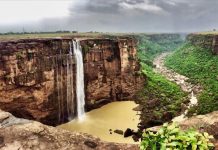Top 20 Things to Do in Ladakh
The remote, high-altitude Union Territory of Ladakh opened to visitors in 1974 after decades of conflict, and has since developed into a prominent tourist destination. Once part of the Tibetan Empire, Ladakh became an independent kingdom in the 9th century, eventually expanding into what is now Western Tibet.
The kingdom prospered as a nexus for the trade of Pashmina wool between Tibet and Kashmir. However, invasion from the Dogra region of neighboring Jammu ended the kingdom in 1834; later, Ladakh was incorporated into the state of Jammu and Kashmir. It became a separate union territory in October 2019.
These days, Ladakh lures tourists with a mix of Tibetan Buddhist culture, dramatic scenery, and outdoor adventure activities. The fact that the region remains cut off by road for most of the year has helped it retain its distinctive customs and lifestyle.
Read on to find out the top things to do in Ladakh and when is the best time to visit Ladakh.
Wander Through Leh’s Main Market
:max_bytes(150000):strip_icc():format(webp)/GettyImages-1024237862-21e9fd7adafc4b8880ba650499432b31.jpg)
If you fly into Leh, Ladakh’s tourist hub, you’ll need to spend a few days there to acclimatize to the high altitude. Start off by wandering through the market area in the town center to orientate yourself. This lively commercial district was recently given a makeover as part of a beautification project. Rows of Ladakhi women sit on the sidewalks selling homegrown local produce, and the shops are stocked with everything from souvenirs to trekking gear (it’s also possible to rent climbing and trekking gear at Venture Ladakh). Check out the Tibetan Refugee Market for prayer wheels, sound bowls, thangka paintings, and jewelry. You’ll find plenty of travel agents to help with your plans as well. Drop into the Central Asian Museum on Main Bazaar Road (open daily from 10 a.m. to 1 p.m. and 2 p.m. to 6 p.m.) to learn about Leh’s role in Silk Road trade.
Take a Heritage Walk of Leh’s Old Town
:max_bytes(150000):strip_icc():format(webp)/GettyImages-832237398-66bdab18a81146459c7b68b5d936b721.jpg)
Behind the market area, Leh’s atmospheric Old Town is an amazingly well-preserved maze of narrow lanes and centuries-old mud brick houses. This rare example of an intact historic Tibeto-Himalayan urban settlement was originally situated within a walled fortification. The New York-based World Monuments Fund has included the Old Town on its list of 100 Most Endangered Sites due to the threat of damage from climate change and poorly-planned modernization. It’s now being preserved by the Tibet Heritage Fund.
Start your exploration of the Old Town at Jama Masjid (mosque) near the market. Attractions include several Buddhist temples and chortens, and the interesting LAMO arts center in a pair of magnificently restored 17th-century mansions. Go on this guided heritage walk so you don’t miss anything.
:max_bytes(150000):strip_icc():format(webp)/GettyImages-601070662-b2f344697cc2495a8bb05ad2277637bd.jpg)
Natapong Supalertsophon/Getty Images
While you’re exploring Leh, make your way over to Leh Palace (formally known as Lachen Palkar Palace), perched above the Old Town. Completed by King Sengge Namgyal in the early 17th century, this former royal palace has outstanding medieval Tibetan architecture. Unfortunately, the royal family were forced to abandon the palace and relocate to Stok in the mid 19th century after the Dogra invasion. Much of it was in ruins until the Archeological Survey of India’s restoration.
Leh Palace can be reached by walking uphill from town or by road. Tickets to go inside cost 300 rupees (about $4) for foreigners, and 25 rupees (about 40 cents) for Indians. The Palace Museum has regal memorabilia for you to check out; however, the superb views over town are arguably the biggest draw.
Spend Sunset at Shanti Stupa
:max_bytes(150000):strip_icc():format(webp)/GettyImages-821319196-3e0231fb129e40b6b38bb8f9c4f3489e.jpg)
Shanti Stupa is another standout place in the vicinity of Leh for views, and it’s particularly evocative at sunset. The white-domed stupa was built between 1983 and 1991 by a Japanese Buddhist group to celebrate 2,500 years of Buddhism. This symbol of peace occupies a barren hilltop in Chanspa, opposite Leh Palace. Get there by taxi or climb about 500 steps to be rewarded with the panoramic view from the top. The stupa is open from dawn to 9 p.m. and is illuminated at night. Head there for sunrise if you like to wake up early.
:max_bytes(150000):strip_icc():format(webp)/GettyImages-1160325166-f9dc4363a1db416c86042233b12f4e3b.jpg)
When many donkeys reach the end of their useful working lives, they are abandoned on the streets, where they become weak and are attacked by stray dogs. Animal lovers will appreciate the wonderful work the Donkey Sanctuary is doing to provide a “home for homeless donkeys” and treat their injuries. The sanctuary cares for up to 30 donkeys at a time, and visitors can pet and feed them. It’s located in Upper Leh, about 15 minutes north of town on Korean Temple Road.
Try Local Food
:max_bytes(150000):strip_icc():format(webp)/GettyImages-811880818-ca5710a8b8004a8288a9ff20fef6b9bf.jpg)
You’ll find that Ladakhi cuisine is heavily influenced by the surrounding regions, including Tibet and Kashmir. Don’t limit yourself to momos (dumplings) and thukpa (noodle soup) when visiting this area. There are many other traditional dishes to try. One of them is skyu, a delicious indigenous pasta stew with root vegetables. Alchi Kitchen at Chhutey Rantak in Leh gives a modern twist to it. Ladakhi Women’s Cafe, a welfare enterprise run by a local group of women in Leh’s main market, serves up inexpensive homestyle lunches. Dzomsa on Fort Road does authentic Ladakhi breakfasts featuring khambir (bread), signature butter tea (with yak butter and salt), and homemade apricot preserve. The Tibetan Kitchen on Fort Road is renowned for its succulent momos and other Tibetan fare.
Visit the Monasteries
:max_bytes(150000):strip_icc():format(webp)/GettyImages-961060522-5bb9baaac9e77c0051839da8.jpg)
Most tourists visit at least one Buddhist monastery in Ladakh. Nearly half the population there practices Tibetan Buddhism, so spectacular monasteries are dotted all over the region. Most can be visited on day trips from Leh or on the way to other destinations. Spituk is the closest monastery to Leh, whereas Lamayuru and Alchi (both on the way to Kargil) are the region’s oldest monasteries. The ancient ruins of Basgo Monastery, near Alchi, are on the WMF’s list of 100 Most Endangered Sites. Diskit Monastery, with its gigantic Maitreya Buddha statue, is in Ladakh’s Nubra Valley. The most incredible (and most inaccessible) monastery is Phugtal, halfway between Padum and Darcha in the Zanskar region. It can’t be reached by road, so you’ll have to trek or ride a pony to it.
Experience Ladakhi Village Life
:max_bytes(150000):strip_icc():format(webp)/GettyImages-103000952-075dee0c104a4ad98f10c53a2be1e3bf.jpg)
Ladakh is a marvelous place to experience village life and there are options for all kinds of travelers. For luxury travelers, Shakti Ladakh has transformed several old village houses in rural Ladakh into elegant lodging; Nimmu House, too, provides quality accommodations in a village setting. Those who aren’t too fussed about facilities will find plenty of homestays in various quaint villages. Farmstays Ladakh is a relatively new initiative that brings visitors to stay with farming families in Phyang and Phey villages. Another community empowerment initiative, Mountain Homestays, has appealing properties in rural Ladakh too. Alternatively, adventurous travelers can join a village-to-village trek, such as the popular Sham Trek (see below). Dreamland Adventures offers numerous homestay treks.
Go Trekking
:max_bytes(150000):strip_icc():format(webp)/GettyImages-522689430-d23cb11197554a40a31b9a4ca033dc3f.jpg)
There are treks for all levels of fitness and experience in Ladakh. The region is quite the trekkers paradise with stark landscapes, high-altitude passes, ancient gompas, unusual flora and fauna, fascinating villages, and even frozen rivers in winter. If you don’t want to camp out, there are now village homestay accommodations on many treks. The four-day Sham Trek is regarded as the beginner’s trek (although it still isn’t easy). It starts in Likir, and goes through the arid Sham region to the west of Leh. If you’re up for a challenge, try the Chadar Trek along the frozen Zanskar River. It’s one of the most difficult in India!
Stay with Royalty at Stok Palace
:max_bytes(150000):strip_icc():format(webp)/GettyImages-139811038-a3590dae23224d2a93330c1deca1e38e.jpg)
19th century Stok Palace, about 30 minutes south of Leh, has been turned into a heritage hotel and private museum of the Ladakhi royal family. The palace overlooks the Indus Valley, and is smaller and cozier than the one in Leh. The erstwhile king still lives there; he’s passionate about conserving Ladakhi culture and likes his discerning guests to have a personal experience. While the museum is open to everyone, overnight guests are given a guided tour of the palace (including the monastery and throne room) and may even dine with the king. Impromptu cooking sessions are possible in the royal kitchen as well. Of course, the privilege doesn’t come cheap. The six carefully restored palace rooms are priced from around 18,000-38,000 rupees (about $250–540) per night, inclusive of meals for two people. They’re only open during the summer months though. Guests can stay in the two-bedroom villas in the royal apricot orchard year-round.
Glamp at High Altitudes
:max_bytes(150000):strip_icc():format(webp)/147429890-267979f6435c4276a110d05f1bd67c17.jpg)
There are plenty of happy glampers in Ladakh. Luxury tented camps have cropped up in popular places such as the Nubra Valley and Pangong Lake. The most glamorous ones are The Ultimate Traveling Camp’s opulent Chamba Camp near Thiksey Monastery and Chamba Camp at Diskit. These seasonal camps are open from mid-May to the end of September or October. Exclusive bespoke itineraries are offered at each. Elsewhere, the 42-acre Indus River Camp is an excellent less-costly option on the river bank, conveniently only 15 minutes from Leh. This stunning location offers activities such as yoga, cycling, rock climbing, and visits to a local camel sanctuary.
Have a Bollywood Moment at Pangong Lake
:max_bytes(150000):strip_icc():format(webp)/GettyImages-617857728-cc5e2cabde9542ef8b509e6c97860dce.jpg)
The final scenes of the 2009 hit movie “The 3 Idiots” were shot at Pangong Lake—and ever since it was released, Indian tourists have been flocking there to have their Bollywood moment (props are even available for hire). At 4,350 meters above sea level, this surreal salt water lake is among the highest in the world. It’s also unusual because it’s completely landlocked. The lake is about a six-hour drive southeast of Leh, on the border of China-dominated Tibet. It’s disputed territory, so permits are required to visit the area. Stargazing is sensational at night!
Spot Himalayan Marmots
:max_bytes(150000):strip_icc():format(webp)/GettyImages-512498503-7bfbe755cc0248abaeb4a1e62fa9b15e.jpg)
Eat at the Highest Cafeteria in the World
:max_bytes(150000):strip_icc():format(webp)/GettyImages-181217892-0b0c1e771be14bd48ff37b8a8c00db30.jpg)
Khardung La, which passes over the Ladakh mountain range on the way to the Nubra Valley, may not actually be the highest drivable road as is often claimed (the Indian government has stated its altitude to be only 17,582 feet above sea level, as opposed to 18,380 feet). However, you can still grab a bite to eat at Rinchen Cafeteria, the “highest cafeteria in the world”. Avoid spending any longer than about 15 minutes there though, as the super high altitude is likely to make you feel lightheaded and unwell.
Ride Camels Through the Sand Dunes
:max_bytes(150000):strip_icc():format(webp)/GettyImages-913027086-ef352496d09b434390f4a53c88987bb2.jpg)
A camel safari through the desert is an iconic thing to do in Rajasthan. It’s also possible in Ladakh, although the camels are the rugged double-humped Bactrian variety. The safaris take place in the sand dunes between Diskit and Hunder in the Nubra Valley. Camel riding also is possible at Sumur, but the dunes are less impressive.
Learn About Balti Culture and Traditions
:max_bytes(150000):strip_icc():format(webp)/GettyImages-181934899-58d08dcc777b41bc9d669b07b942fb43.jpg)
It’s often said that India is one of the most diverse countries in the world. You’ll really understand why at the Balti village of Turtuk in the Nubra Valley, close to the Pakistan border. Baltistan was part of Pakistan until India reclaimed some of it during the 1971 Indo-Pakistani War, and Turtuk was off-limits to tourists until 2010 due to security concerns. The Balti Heritage Museum in Turtuk showcases local history, starting from the time the village was inhabited by the Brokpa tribe and later overtaken by warriors from Central Asia. See if you can meet the “king” of Turtuk, Yabgo Mohammad Khan Kacho, a descendant of the Yabgo Dynasty that ruled Baltistan for 2,000 years. He still lives in the former palace and has set up a museum there dedicated to the dynasty’s memorabilia. Old wooden mosques that have withstood the test of time are another attraction in Turtuk. Spend a night or more in a luxury tent at Turtuk Holiday Resort or Maha Guest House. Balti Farm at Turtuk Holiday Resort prepares fabulous Balti cuisine.
Get an Adrenaline Rush from River Rafting
:max_bytes(150000):strip_icc():format(webp)/GettyImages-905848746-5b6d5964ee254049a3f2c2a24b960952.jpg)
River rafting in Ladakh is one of the top adventure activities in India and a whole lot of fun. It takes place along the Indus and Zanskar rivers, with various grade rapids for all levels. The Chilling-to-Nimmu stretch of the Indus River is ideal for white water junkies who love an adrenaline rush, as there are plenty of rapids on this three-hour, grade 3+ stretch. Splash Ladakh is one of the best rafting operators. You’ll be picked up from your hotel in Leh early in the morning, driven to Chilling (an hour and a half away), collected from the end point near Nimmu, and dropped back at your hotel mid-afternoon. Longer rafting expeditions with riverside camping are offered, too.
Marvel Over Magnetic Hill
:max_bytes(150000):strip_icc():format(webp)/GettyImages-537580813-a0567e722f3e4064a1c0ae878b788d5c.jpg)
Is it an optical illusion, or is something more mysterious going on at gravity-defying Magnetic Hill on the the Srinagar-Leh Highway? Place your car in neutral gear and it will appear to roll uphill on this bizarre stretch of road. According to the sign, there’s a real magnetic force at play. Locals and the Indo-Tibetan Border Police have claimed that the magnetic power can be experienced if flying above the hill in a helicopter or airplane as well. You’ll find Magnetic Hill just before the confluence of the Zanskar and Indus rivers near Nimmu, about a 30-minute drive from Leh.
Admire the Confluence of the Indus and Zanskar Rivers
:max_bytes(150000):strip_icc():format(webp)/GettyImages-461140685-b01d493d3d554fa781fae404ade497c8.jpg)
The Indus and Zanskar rivers meet not far from Nimmu (at a place locally called sangam) and it can be seen from a picturesque viewpoint on the Srinagar-Leh Highway. The color of the water is renowned for changing—from green to blue to gray—throughout the day and year. Aim to be there in the morning around 10:30 a.m. for the best light and brightest spectacle. It’s quite awe-inspiring. What’s also astounding is that the Zanskar River freezes over in winter, while the Indus flows faster with ice floating on it. After admiring the vista, head to Nimmu village for lunch.
Pay Your Respects to Kargil War Heroes
:max_bytes(150000):strip_icc():format(webp)/GettyImages-466484716-9d27b98d959f4e70b6cf25bc5fb98135.jpg)
The highway between Srinagar and Leh passes through Kargil in western Ladakh. This town is roughly equidistant from each place (five hours) and is considered to be the gateway to Ladakh. Unfortunately, it has been the site of some awful border clashes with Pakistan. The worst of these was the Kargil War in 1999. The Indian Army has built a Kargil War Memorial at the war zone in Drass (about an hour from Kargil towards Srinagar) to honor the hundreds of soldiers who lost their lives defending India from invasion. A 20-minute documentary about the war is screened at the memorial. Other attractions include a Bofors gun, MiG-21 fighter aircraft, war bunkers, an eternal flame, and stones with soldiers names engraved on them. It’s very moving and thought-provoking.


















